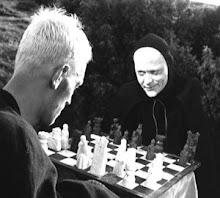Prospect Theory 101 and the Irrational Man Standard
Roger, the guy at Limited, Inc., has been lately engaged in a discussion of Prospect Theory (PT). Figures associated with PT, such as Kahneman and Tversky, assessed data from psychological testing in attempts to demonstrate patterns in human decisions relating to a person's perspective of probabilities, or imagined probabilities; the results from such testing altered the way economists and other social scientists think of the Rational Man Standard as it formerly was known. (Keynes, I believe, also addressed this issue somewhere--or at least questioned the objectivity of the standard.}
Paraphrasing Mr. Roger's paraphrase of Kahneman and Tversky, K & T discovered that certain patterns of error occured across groups, and that responses to certain questions seemed dependent on the wording or "framing" of the question, as some semanticists call it. As Mr. Roger said, "given a constant probability of a course of action, one can manipulate responses to that course [of action] by framing it in terms of gain or loss. K and T developed what is called the Asian disease problem. Using students and professors as their pool of respondents, they posed this problem:
"Imagine that the US is preparing for the outbreak of an unusual Asian disease, which is expected to kill 600 people. Two alternative programs to combat the disease have been proposed. Assume that the exact scientific estimates of the consequences of the programs are as follows:
If Program A is adopted, 200 people will be saved.
If Program B is adopted, there is 1/3 probability that 600 people will be saved, and 2/3 probability that no people will be saved.
72 percent chose A, 28 B.
Then K & T proposed this problem:
Problem 2
If Program C is adopted 400 people will die.
If Program D is adopted there is 1/3 probability that nobody will die, and 2/3 probability that 600 people will die.
Which of the two programs would you favor?”
22 percent went for C, and 78 percent went for D."
Note that the programs offer the same probability of people being killed or saved, yet it appears that a majority of people prefer the frame of 200 people being saved to the frame of 400 being killed. Andre Breton might have applauded.
Here's more of Roger's analysis of the results of K & T's investigation: "The first question was framed in such a way that it brought out risk averseness: “the prospect of certainly saving 200 lives is more attractive than a risky prospect of equal expected value, that is, a one-in-three chance of saving 600 lives.” The second question brought out risk taking: “the certain death of 400 people is less acceptable than the two in three chance that 600 will die.”"
Any semi-awake undergraduate social-studies type would ask to review the sample and the distribution of the data--including the number of people questioned, their education, race, gender, and geographic location--but the research may at the very least provide more anecdotal evidence of the pathological status of your fellow primates.
Saturday, June 04, 2005
Subscribe to:
Post Comments (Atom)

Custom Search
Blog Archive
-
▼
2005
(57)
-
▼
June
(8)
- Quine's Two Dogmas of EmpiricismQuine's Two Dogmas...
- Economic equity and conservatismIf conservatism is...
- Feds crack down on medical potThe Baronial Masters...
- Ay Laddy Contingencies is not usually one for the ...
- On Power, Russell "The orthodox economists, as wel...
- The Jacko the Chester ShowAnother episode in the C...
- Prospect Theory 101 and the Irrational Man Standar...
- The McSynthetic A Priori and Fries pleaseHere's a ...
-
▼
June
(8)

No comments:
Post a Comment